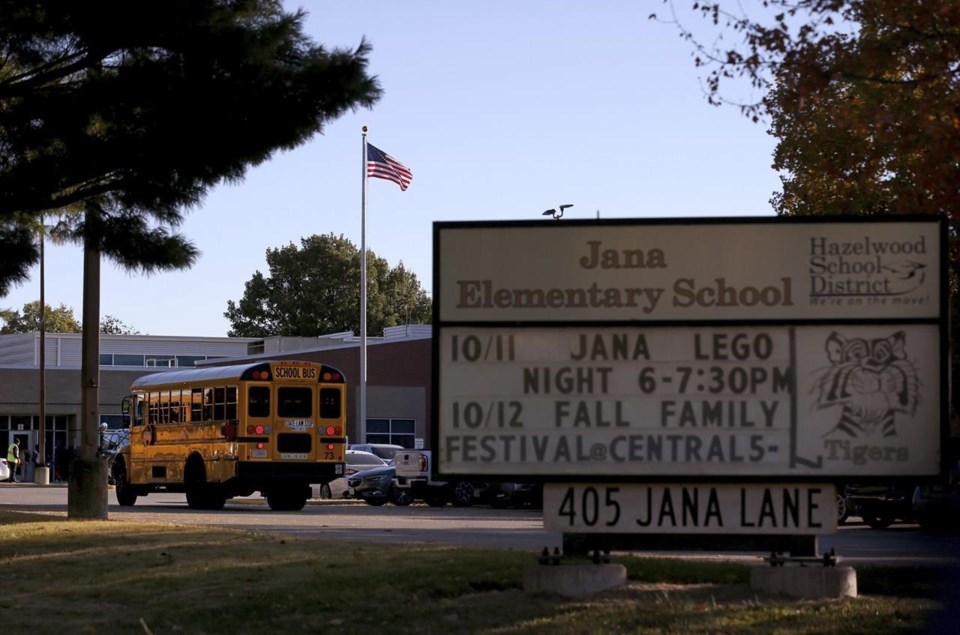FLORISSANT, Mo. (AP) — Testing by the U.S. Army Corps of Engineers found no radioactive contamination at a Missouri school that was amid fears that nuclear material from a contaminated creek nearby had made its way into the school, Corps officials said Wednesday.
Teams from the Corps' St. Louis office began testing the interior of Jana Elementary School in Florissant, Missouri, and the soil around it in late October, days after the school board closed the school.
The closure followed that found levels of radioactive isotope lead-210 that were 22 times the expected level on the kindergarten playground, as well as concerning levels of polonium, radium and other materials inside the building. The private study was funded by lawyers whose clients are suing over contamination in the creek.
The Corps said preliminary results found no evidence of radioactive material above what would be naturally occurring.
“From a radiological standpoint, the school is safe,” Col. Kevin Golinghorst, St. Louis District commander for the Corps of Engineers, said in a news release. “We owe it to the public and the parents and children of Jana Elementary School to make informed decisions focused on the safety of the community, and we will continue to take effective actions using accurate data.”
Ashley Bernaugh, president of the Jana Elementary PTA, disputed the Corps’ findings, saying the agency had found contamination near the school site.
“I think the Corps is using semantics and not mathematics to explain their take on the contamination. ... It’s misleading to come to (the school and the PTA) and lie to their faces. It’s obscene,” she said.
Bernaugh said she wasn’t sure why the Corps would be untruthful but she assumed it would be easier for the agency if it could leave some contamination in the dirt in the areas.
Corps spokesman J. P. Rebello said in a statement that the agency stood by its results, noting it took nearly 1,000 samples and measurements throughout the school and grounds and found no radioactive material above levels found in nature. Golinghorst noted that 53 of the samples were taken from soil on school grounds.
The Corps said a public event will be held Nov. 16 to discuss the findings with the community.
A spokeswoman for the Hazelwood School District declined to comment.
The school, with about 400 students, sits along Coldwater Creek, a 19-mile (31-kilometer) waterway contaminated decades ago with Manhattan Project atomic waste. The Corps used radiation detection instruments to scan surfaces inside the school, and dug holes up to 28 feet (8.5 meters) deep in the soil.
Students are taking virtual classes for the next month, then will be reassigned to other schools. It hasn’t been determined when Jana Elementary will reopen.
Coldwater Creek was contaminated in the 1940s and 1950s when waste from atomic bomb material manufactured in St. Louis got into the waterway near Lambert Airport, where the waste was stored. The result was an environmental mess that resulted in a Superfund declaration in 1989.
The site near the airport has largely been cleaned up but remediation of the creek itself won’t be finished until 2038, Corps officials have said.
Children have often played in the creek, and a 2019 federal report determined that those exposed to the waterway from the 1960s to the 1990s may have an increased risk of bone cancer, lung cancer and leukemia. Environmentalists and area residents have cited several instances of extremely rare cancers that have sickened and killed people.
The Corps of Engineers earlier found contamination in a wooded area near the school, but hadn’t previously tested the school or its grounds. This summer, lawyers involved in a class-action lawsuit representing local residents seeking compensation for illnesses and deaths received permission from the Hazelwood School District to perform testing.
Results from testing done by Boston Chemical Data Corp. were released in October, prompting the decision to shut down the school. Phone and email messages seeking comment from the law firm funding the testing weren't returned.
Marco Kaltofen, who wrote the Boston Chemical report, said Wednesday he didn't distrust the Army Corps’ testing but that his team used “microscopic methods” to look for contamination, The St. Louis Post-Dispatch reported.
Hazelwood School Board treasurer Sylvester Taylor said school district leaders are confused by the conflicting information.
“I’m upset because I feel like we’re pawns in this,” Taylor said. “I feel like we have one report that’s biased saying that you need to get the kids out. I got another report that’s also biased that’s saying you got nothing, and that’s what we’re grappling with this morning.”
It’s unclear exactly what any cleanup would involve, how long it would take or who would pay for it.
Jim Salter, The Associated Press



